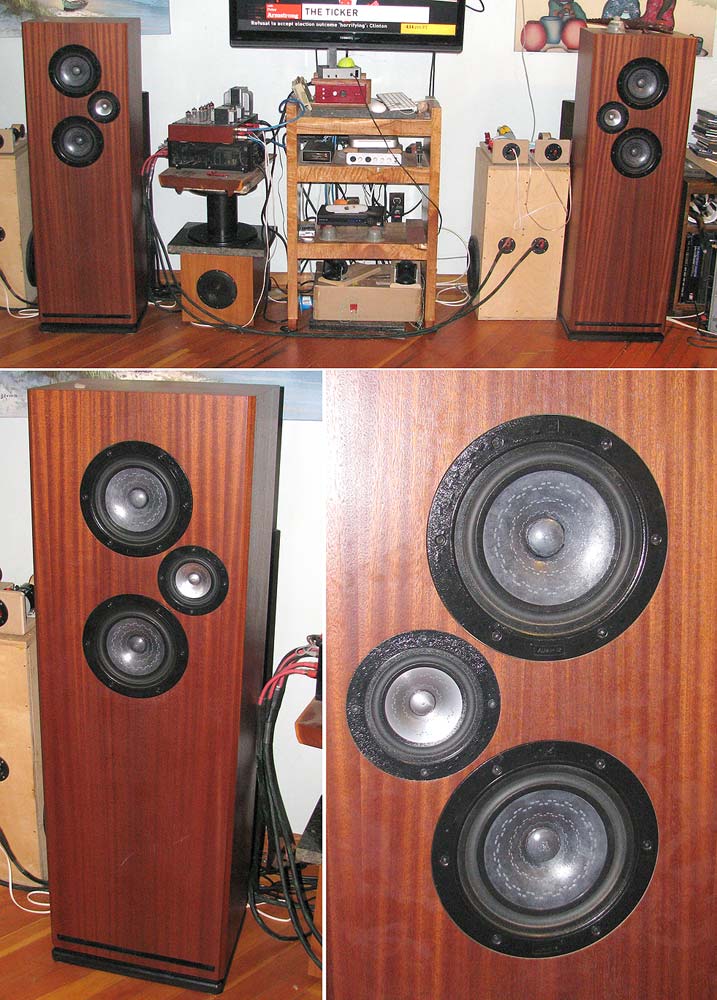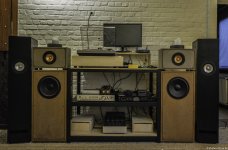Indeed.
Winisd is reasonably close to "infantry proof", hard to get it wrong really.
Given the degrees of freedom in a reflex enclosure, it is pretty easy to sim a bad box. The user still needs to know what is being spit out.
dave
I remain dumbfounded at the hobbyist's reliance on software as the Gospel. I'm using Firefox version 91.01 - obviously there were issues with the 200+ previous versions. Should I mention the Intel processor that was recalled because it was notoriously bad at math?
There is much to be learned from inquisitive minds. e.g. I still have a Celestion CS135 connected to my test rig. If I connect the Panasonic 3-way bookshelf speakers the system sounds good. Even after the crossover the woofer can reach Xmax and excite the port to the extent that it will easily extinguish a lighted match - even at low volumes. Connect the Toshibas and it's a different story. The woofer barely moves, the port has no interest in making a contribution to the overall sound.
I learned a long time ago: on the Internet, if you want to test someone's experience or intelligence, ask the a question that can't be answered by a Google search.
There is much to be learned from inquisitive minds. e.g. I still have a Celestion CS135 connected to my test rig. If I connect the Panasonic 3-way bookshelf speakers the system sounds good. Even after the crossover the woofer can reach Xmax and excite the port to the extent that it will easily extinguish a lighted match - even at low volumes. Connect the Toshibas and it's a different story. The woofer barely moves, the port has no interest in making a contribution to the overall sound.
I learned a long time ago: on the Internet, if you want to test someone's experience or intelligence, ask the a question that can't be answered by a Google search.
Surtsey, I'm sure many of us here have tried to tune a box too low before, and didn't like the sound of it. Isn't that your experience too?
I don't think it's that. The Toshibas were originally tuned to 55hz (50mm). It has 'snugfit' ports. By removing the ports the tuning frequency is raised to 75Hz. My speakers have a vent length of 100mm (45Hz).
Whatever the tuning frequency the port seems to have little or no interest in making a contribution to bass output. I suspect the phenomenon is related to air compression and port resistance in an oversized cabinet. A bigger driver is the most obvious solution. Doubling-up on bass drivers is my favoured solution. Reducing the cabinet volume is not an option: only a complete idiot would give up real estate for free.
Whatever the tuning frequency the port seems to have little or no interest in making a contribution to bass output. I suspect the phenomenon is related to air compression and port resistance in an oversized cabinet. A bigger driver is the most obvious solution. Doubling-up on bass drivers is my favoured solution. Reducing the cabinet volume is not an option: only a complete idiot would give up real estate for free.
When all is said and done, no 6.1/2" driver could ever provide any useful spl below 50Hz. Can't cheat physics, folks.
When designing a port, always start with an area equal to Sd (sometimes you get lucky!) and work backwards from there until it fits in the box!
When designing a port, always start with an area equal to Sd (sometimes you get lucky!) and work backwards from there until it fits in the box!
2 can.
dave
I guess we have different ideas of spl - that's still only the Sd of an 8"...
There certqinly wa sno complaints when Dark Side of the moon was played on our big MTMs with Tom’s 200w prototype amp. In my biggish room.

At least a dozen witnesses.
One would have to be listening at pzrticualrily ear-damaging levels to have payed louder.
dave

At least a dozen witnesses.
One would have to be listening at pzrticualrily ear-damaging levels to have payed louder.
dave
There certainly was no complaints when Dark Side of the moon was played on our big MTMs with Tom’s 200w prototype amp. In my biggish room.
At least a dozen witnesses.
One would have to be listening at particualrily ear-damaging levels to have payed louder.
dave
What sort of spl do you get south of 50Hz?
Lots. No one was asking for louder. Everyone was enjoying it to much to pull out an SPL meter. The boxes could pressurize some parts of the room (really hard to do, given my room)
dave
dave
and i got my neighbours complaining about the bass my MLTL's did while i was watching/listening to the OBF (a french dub soundsystem) livestream with a 35w tube amp with volume 3/4th open last winter.... driver is the CHN110 (5 ¾ inch cone) fullrange driver. We measured 102dB (c-weighted spl meter) then (with a pair). Those are the black boxes in the picture with the silver driver. The other system was not connected then.
Attachments
Last edited:
I'm going to attempt to explain this very simply and logically. I have a pair of Toshiba floor standing speakers Each cabinet volume is 22litres and they contain Peerless 6.5" bass drivers. I also have a pair of Sony home theatre subwoofers with 6.5 drivers. Putting the cabinets side by side it is apparent the Sony sub cabinets occupy virtually the same volume as the dead space in the Toshibas.
Logic dictates that I transplant the Sony drivers into the lower half of Toshiba cabinets and throw the Sony cabinets away.
This creates two issues: (1) Do I need to seal the woofer from the sub-woofer or can they use the same airspace? This issue how created a lot of contention because popular software is unable to model two drivers of differing specs using the same air -space. My solution is simple. Separate the drivers in one cabinet, leave the other open, a go with the design I prefer the sound of. (2) Impedance: Assuming both drivers are 4 Ohms, If I use a 6mH coil on the sub-driver and a 500uF capacitor what will my nominal resistance be?
Logic dictates that I transplant the Sony drivers into the lower half of Toshiba cabinets and throw the Sony cabinets away.
This creates two issues: (1) Do I need to seal the woofer from the sub-woofer or can they use the same airspace? This issue how created a lot of contention because popular software is unable to model two drivers of differing specs using the same air -space. My solution is simple. Separate the drivers in one cabinet, leave the other open, a go with the design I prefer the sound of. (2) Impedance: Assuming both drivers are 4 Ohms, If I use a 6mH coil on the sub-driver and a 500uF capacitor what will my nominal resistance be?
1) As you mentioned, you can do whatever you'd like.(1) Do I need to seal the woofer from the sub-woofer or can they use the same airspace? (2) Impedance: Assuming both drivers are 4 Ohms, If I use a 6mH coil on the sub-driver and a 500uF capacitor what will my nominal resistance be?
2) Not enough wiring information, but assuming parallel 4 ohm drivers, one using a series coil and parallel capacitor, nominal impedance would shift from 2 ohms below the crossover point to 4 ohms above.
At Fb, the impedance may be near the DCR of both drivers in parallel if both share the same enclosure volume.
Or a different impedance, since you say the port had no contribution with one driver...
Last edited:
- Home
- Loudspeakers
- Subwoofers
- Port Tuning Frequency & Port Volume

